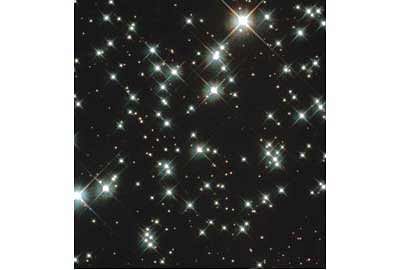A journey back in time

Ancient white dwarf stars in the Milky Way galaxy. Courtesy: Hubble Telescope Photos
From time immemorial, we gazed at the night sky and were fascinated by the sight of the moon, stars, meteors, comets, and neighboring planets. We wish upon a shooting star. We wonder how our lives are connected to the objects that adorn the sky.
This is naked eye astronomy practiced by ancient astronomers who gazed at the sky and studied the complex ballet of motion of visible objects for years and years. Their universe the totality of all space, time, matter, energy - was small, quaint, and tidy with gods playing a dominant role.
Modern astronomy is a journey through two inseparable "abstract entities" - space and time. Some of the journeys are voyages made by us, like the lunar missions of the 1960's. Others involved machines we have built - the space-based telescopes and unmanned space probes, for example. These journeys have expanded the realm of our experience from the Earth to the Moon and allowed us to reach the outer edge of the solar system and beyond.
Astronomy is also a trip of the intellect through the universe. The distances that our mental journeys took us have grown steadily to the point where we now have astounding knowledge of how the universe works. We know its properties as a whole: its physiology, origin, evolution, and eventual fate.
Electromagnetic radiation, ranging from high energy gamma rays to radio waves, is our measuring stick in space. It is the cosmic messenger that carries far more information than any other messenger. By studying and analyzing light and radiation from far away objects, we know precisely the chemical composition of distant stars, their distance, size, surface temperature, luminosity, brightness, etc. We can figure out the nuclear reactions that are taking place at their core. We can determine whether a galaxy is approaching us or receding away from us. We can also calculate their speed of approach or recession with great degree of accuracy.
When we look at a distant star, do we see it as it is at the time of observation? The answer is no. Because it takes time for light to travel through space, astronomy is a journey back in time. When we look out to large distances, we look back in time and see the universe at an earlier epoch. For example, when we observe the nearest star Proxima Centauri which is about 4.24 light years (ly) away, we are observing the star as it was 4.24 years ago. (One light year is the distance traveled by light in one year which is 9.46 trillion km.) Thus by looking into the past, we can observe the birth and growth of galaxies as the universe ages. Some of the stars and galaxies that we see today probably don't even exist anymore because their light has taken so long to get to us. They are either dead, or have exploded and collapsed into white dwarfs, or supernovae, or black holes.
The speed of light puts a limit on the size of the universe. The finite age of approximately 14 billion years of the universe means light from beyond 14 billion light years (ly) away has not yet reached us. The observable universe, therefore, extends 14 billion ly in all direction from the Earth. In other words, we can describe the universe as it looked 14 billion years ago. Furthermore, if we looked at objects that are nearly 14 billion ly away, we would see them as they were moments after the Big Bang. It is an amazing thought that today we have the scientific tools to witness the cosmic birth.
It is also amazing to realize that any "snapshot" of a distant galaxy is a picture of both space and time. For example, the galaxy Andromeda is about 2.5 million ly away from earth. A picture of Andromeda, therefore, shows how it looked like 2.5 million years ago. Moreover, its diameter is about 100,000 ly. So light from the far side of the galaxy required 100,000 years longer to reach us than light from the near side. Thus the picture will show 100,000 years of time. This is what the Hubble telescope has been doing for the past two decades.
"We find them smaller and fainter, in constantly increasing numbers, and we know that we are reaching into space, farther and farther, until, with the faintest nebulae that can be detected with the greatest telescopes, we arrive at the frontier of the known universe." Edwin P. Hubble

 For all latest news, follow The Daily Star's Google News channel.
For all latest news, follow The Daily Star's Google News channel. 



Comments